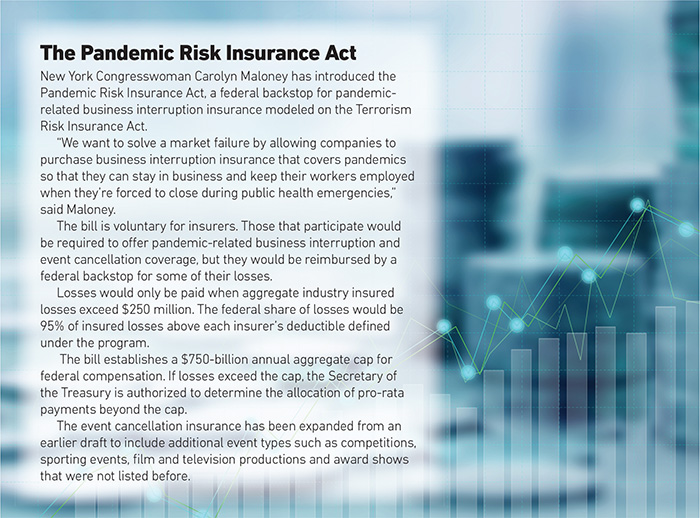Considering Buying Business Interruption Coverage? You Better Understand How COVID-19 Changed the Game Forever

Business interruption (BI) insurance was originally designed to protect companies in the event of a loss caused by physical property damage.
The coverage, usually bought as part of a business owner’s insurance policy or added to a commercial property policy, compensates firms for lost revenue and other expenses if an event such as a fire, flood or other disaster forces them to shut temporarily.
But in the wake of the COVID-19 pandemic, many business owners have called into question the very purpose of BI insurance.
Faced with financial losses on an unprecedented scale after being mandated to shut under civil authority orders, firms have been filing claims in a desperate bid to try and recoup their money.
Yet, insurance companies have, in the main, denied payment, because the pandemic didn’t cause damage to property. The standard policy language also explicitly states that an insurer won’t pay for loss or damage resulting from a virus or bacterial infection, which was reinforced in 2006 after the SARS outbreak.
However, while most carriers clearly stipulate what is covered under BI, there remain many untested gray areas that are widely open to interpretation, such as whether BI was caused by the virus or a government or state order.

Finley Harckham, litigator, Anderson Kill
“The main issue is that many businesses view the fact they have got BI coverage to mean that they should be covered in the event their business is disrupted, for whatever reason,” said Finley Harckham, a shareholder and litigator at Anderson Kill, specializing in representing policyholders pursuing insurance claims.
“That’s understandable when there can often be confusion around the level and variation of coverage available.”
So how, if at all, are underwriters and brokers changing their attitudes towards BI as a risk and its coverage? And what effect has COVID-19 had on the awareness of insureds, their risk managers and their appetite for such policies?
Tighter Exclusions
In the aftermath of the pandemic, insurers have already started adding far tighter exclusions to their BI policies. It’s a trend that Mark Humphreys, chair of RIMS external affairs committee and vice president, litigation and risk management for Watt Companies, only sees gaining pace.
“We saw that at our May 1 renewal, when all of the underwriters without exception inserted new exclusions into their policies,” he said.
“As time goes on, BI coverage is going to become far more restricted and refined in its language to remove any possible ambiguities in future policies.”
Even carriers who previously offered insurance for risks such as communicable diseases have started reducing limits, according to Rick Miller, U.S. property practice leader at Aon Risk Services.
Others have excluded them from coverage altogether.
Michele Sansone, president of AXA XL’s North America property insurance team, said that obtaining BI values and accurate risk exposures is difficult.
Therefore, she said that the onus is on policyholders and brokers to provide more detailed information, broken down by location, in order to get the most accurate and comprehensive coverage going forward.
“Underwriters are under a lot of pressure, and they need to make sure that all coverages provided are substantiated,” Sansone said.
“If an underwriter can’t get comfortable with an exposure, they are not going to write it, or they are going to price it higher.”
With lawsuits mounting by the day, it’s inevitable legal precedents will be set by courts governing BI coverage in the event of a pandemic.
Among one of the biggest areas of contention, she believes, could be civil authority orders.
“There are going to be lots of disputes around burden of proof about the purpose of an order of civil authority and whether you should get coverage if the order didn’t relate specifically to your premises,” Harckham said.
“Ultimately, though, that may at least give some clarity on how civil authority coverage works.”

Scott Carpinteri, senior vice president, innovative risk solutions at Swiss Re Corporate Solutions, warned that if courts or governments compel carriers to offer new insurance for risks that weren’t previously intended to be covered with BI policies, such as pandemic, it could result in narrower policy language and reduced coverage for the perils currently included.
Possible Solutions
As far as long-term solutions are concerned, the American Property Casualty Insurance Association and other industry bodies have proposed the COVID-19 Business and Employee Continuity and Recovery Fund to help companies that suffer financial losses from a pandemic. The Fund would be backed by the federal government, similar to the current Terrorism Risk Insurance Act.
Another potential answer is the use of parametric tools that trigger coverage payout based on measurable events, according to Gary Marchitello, chairperson of Willis Towers Watson’s North American Property Practice.
After the data is verified by an independent third party, insurers can help to speed up and make the loss adjustment process more accurate, he added.
“After the trigger condition is met, the entire limit of liability can be paid if the coverage is structured as such or a graduated payment can be made based upon defined parameters as to severity measurement of the event,” Marchitello said.
“At least one parametric-type product was placed for pandemic risk, sponsored by The World Bank, and payout conditions were based upon pre-defined trigger criteria, in terms of officially confirmed cases, growth rate, fatalities and international spread.”
A key lesson to come out of COVID-19, according to Jill Dalton, managing director of Aon’s U.S. Property Risk Consulting Group, was the need for better communication on coverage between all parties in the insurance chain.
That includes working with clients to help them understand their policies, she said.

Mark Humphreys, vice president, litigation and risk management, Watt Companies
“Communication is key; clients need to work with their brokers and insurers to make sure that they fully understand the terms of their coverage,” Dalton said.
“Clients also need to communicate the risks they are covered for, as well as what’s excluded to their key stakeholders.”
Increasing Appetite
Currently, only around 30% of U.S. small companies have BI insurance, according to industry estimates. But given the growing awareness around BI resulting from COVID-19, Harckham believes that policyholders’ appetite for the coverage will only increase in the future.
“Most likely, there are going to be companies that will pay a hefty premium to protect their business,” Harckham said.
“But along with the tightening of exclusions, I would expect that some insurers will only sell to certain segments of the economy where they deem the risks are not too high.”
The demand for communicable disease coverage will likely increase following the pandemic. But that doesn’t mean carriers will have the appetite to cover it.
“Insurers’ appetites to continue writing BI insurance will likely depend on court decisions and legislation,” said Chris Cheatham, CEO of RiskGenius. “If courts start finding coverage for pandemic-caused shutdowns, I anticipate insurer appetite would diminish as the potential losses in a future pandemic would be catastrophic.
“If state legislation creates retroactive coverage for shut down businesses, I anticipate some carriers would exit those markets going forward.”
COVID-19 will, however, present insurers with the opportunity to sell add-on coverage for these new emerging risks. It will also prompt a move towards tailored BI insurance for specific industries.
“BI affects different businesses in different ways; for example, retail and remote serviced-based industries present completely different risks,” said Rashik Adhikari, founder and CEO of Covered by SAGE.
“How coverage is written moving forward is going to vary from company to company and by sector.” &










